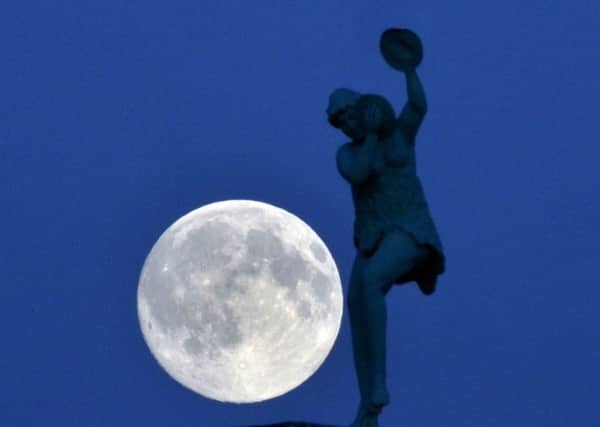Once in a blue moon: Remember to look up tonight


Not just any full moon, a “blue moon” - the first to occur since 2012 and the last until 2018.
But anyone hoping to see the dazzling spectacle of a glowing sapphire celestial body crossing the sky will be sadly disappointed. A blue moon (usually) is silvery grey, like any other.
Advertisement
Hide AdAdvertisement
Hide AdThe term “blue moon” refers to the second of two full moons appearing in the same calendar month.
It has more significance for astrologers than astronomers, marking a time of upset, change and possibilities.
Then there’s that mournful ballad, Blue Moon, one of the most infectious earworms ever written. Composed by Richard Rodgers and Lorenz Hart in 1934, it was a hit on three occasions and covered by Elvis Presley in 1956.
The phrase “once in a blue moon” describes an event that is rare or special.
Advertisement
Hide AdAdvertisement
Hide AdIn fact calendar blue moons are not so incredibly rare. The last one occurred on August 31, 2012, and the next will be seen in another three years on January 31, 2018.
Tonight’s lunar phase on July 31 fits the calendar definition of “blue” because there was another full moon on July 2.
To make things more complicated, there is a different “seasonal” definition that says a blue moon is the third of four full moons in one season. According to this definition, this full moon is not blue at all. The next seasonal blue moon is not due until May 26, 2016.
Just occasionally the moon really can be coloured blue - but you normally need to be near a volcanic eruption to see the phenomenon.
Advertisement
Hide AdAdvertisement
Hide AdIn 1883, blue moons appeared almost every night after the Indonesian volcano Krakatoa exploded with the force of a nuclear bomb.
Plumes of ash rising high into the atmosphere acted like a filter only allowing blue moonlight to pass through the tiny particles.
Blue coloured moons were also seen in 1983 after the eruption of the El Chichon volcano in Mexico. There were other reports of blue moons caused following the Mount St Helens and Mount Pinatubo volcanic eruptions in 1980 and 1991.
Wildfires producing smoke containing one micron-wide ash particles can also produce a properly blue moon.
Advertisement
Hide AdAdvertisement
Hide AdBlue moons are due to the difference between calendar and lunar months. While a calendar month lasts from 28 to 31 days, a lunar month - the time interval between two full moons - is always 29.53 days long.
• Use the buttons on this page to send us your pictures of the blue moon.
How Often Does a Blue Moon Occur?
Over the next 20 years there will be about 12 blue moons, with an almost equal number of both types of blue moons occurring.
The more recent phenomenon, where the blue moon is considered to be the second full moon in a calendar month, last occurred on August 31, 2012. Two full moons in one month may occur in any month out of the year except for February, which is shorter than the lunar cycle.
Advertisement
Hide AdAdvertisement
Hide AdThe other, older blue moon event, which happens when there are four full moons in a season, last occurred Aug. 21, 2013. Since this type of blue moon is reckoned according to the seasons, it can only occur in February, May, August, or November, about a month before the equinox or the solstice.